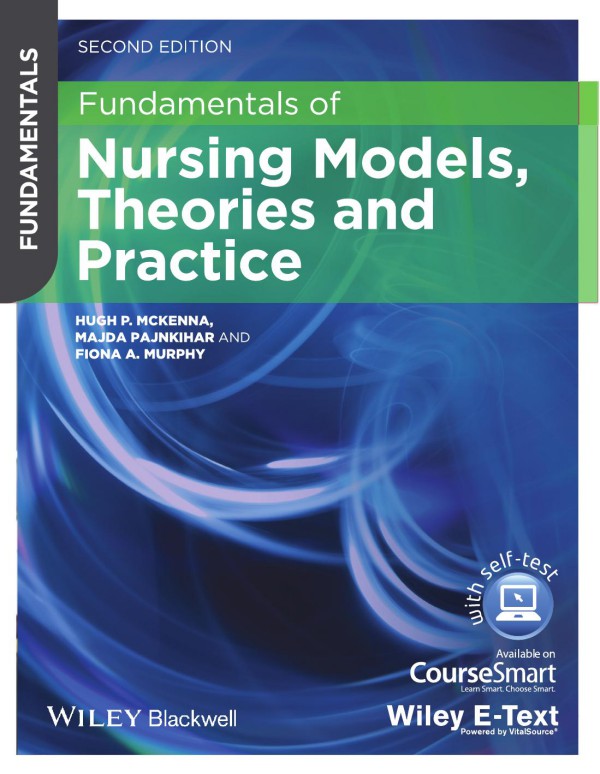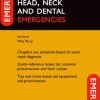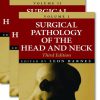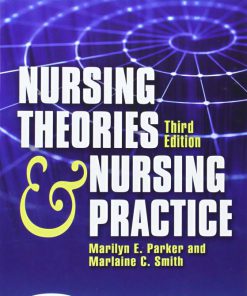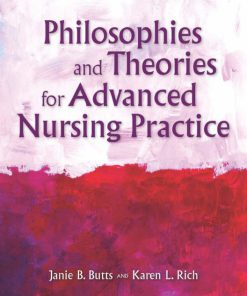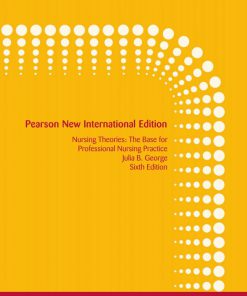Fundamentals of Nursing Models Theories and Practice Wiley E Text 2nd Edition by Hugh McKenna, Majda Pajnkihar, Fiona Murphy 0470657766 9780470657768
$50.00 Original price was: $50.00.$25.00Current price is: $25.00.
Authors:Hugh McKenna , Author sort:McKenna, Hugh , Published:Published:Mar 2014
Fundamentals of Nursing Models Theories and Practice Wiley E Text 2nd Edition by Hugh McKenna, Majda Pajnkihar, Fiona Murphy – Ebook PDF Instant Download/Delivery. 0470657766, 9780470657768
Full download Fundamentals of Nursing Models Theories and Practice Wiley E Text 2nd Edition after payment
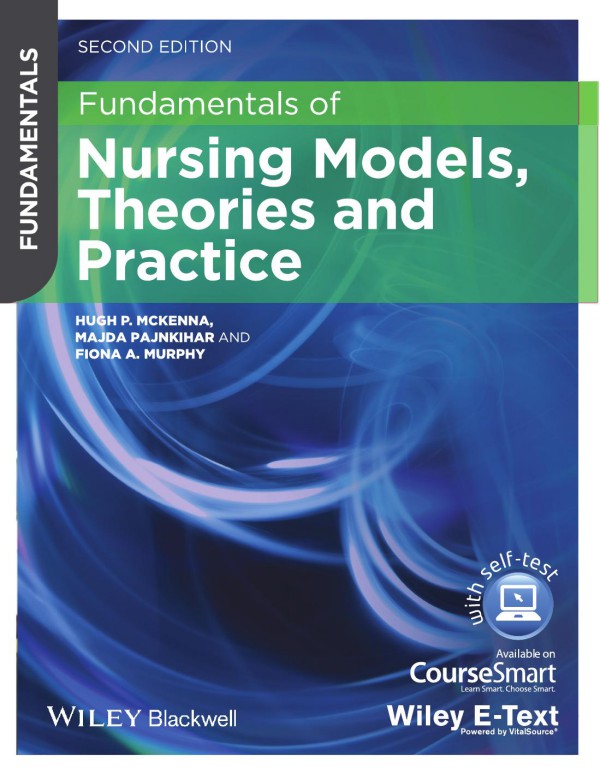
Product details:
ISBN 10: 0470657766
ISBN 13: 9780470657768
Author: Hugh McKenna, Majda Pajnkihar, Fiona Murphy
A concise, accessible introduction to the development, application and evaluation of nursing theories, this new edition of Fundamentals of Nursing Models, Theories & Practice provides a thorough overview of the body of knowledge on the topic, and a clear outline of their relevance to everyday nursing practice. Linking the development of theory to practice, this full-updated text features learning outcomes, key concept summaries and reflective exercises to aid the study of this key element of all modern nursing courses.
Fundamentals of Nursing Models Theories and Practice Wiley E Text 2nd Table of contents:
1 The case for nursing theory
Outline of content
Learning outcomes
Introduction
Reflective Exercise 1.1: Theory
Reflective Exercise 1.2: Terminology
The necessity and meaning of theory
Theory defined
Reflective Exercise 1.3: Phenomena
Reflective Exercise 1.4: Concepts
Reflective Exercise 1.5: Proposition
Key Concepts 1.1
Key Concepts 1.2
Reflective Exercise 1.6: Defining theory
Reflection on the definition
Figure 1.1 The links between theory and practice.
Theory or model
Construction of theory
Figure 1.2 Theory as construction.
Figure 1.3 Nightingale theory of nursing.
Reflective Exercise 1.7: Building theory
Theory and science of nursing
Figure 1.4 Correlation: education, science and practice.
Other interpretations of theory
Reflective Exercise 1.8: The theory-practice gap
Main paradigms and philosophies and their influence on the development of nursing science
Reflective Exercise 1.9: The theory–paradigm relationship
Reflective Exercise 1.10: The place of theory in science
Theory and practice of nursing
Figure 1.5 Basic structure of nursing. Reproduced from Pajnkihar M (2003) Theory development for nursing in Slovenia. PhD thesis. Manchester: University of Manchester, Faculty of Medicine, Dentistry, Nursing and Pharmacy.
Do we really need theory?
Nursing theories today
Nursing theories in the United States
Nursing theories in the UK
Nursing theories in Slovenia
Nursing theories in Russia
Nursing theories in Poland
Nursing theories in Croatia
Level of education and knowledge development
Nursing theories in contemporary nursing
Conclusion
Revision Points
Additional reading
2 Knowing in nursing and nursing knowledge
Outline of content
Learning outcomes
Introduction
Defining knowing and knowledge
Key Concepts 2.1
Reflective Exercise 2.1: Shared knowledge
Philosophies of knowledge
Table 2.1 Philosophies of knowledge.
Rationalism
René Descartes
Cartesian dualism
Reflective Exercise 2.2: Theory – Cartesian dualism in practice
Empiricism
Key Concepts 2.2
John Locke and empiricism
Primary and secondary qualities
Auguste Comte and positivism
Reflective Exercise 2.3: Exploring knowledge
‘The Vienna Circle’
Popper: principle of falsification
Key Concepts 2.3
Post-positivist empiricism
Reflective Exercise 2.4: Nursing and empiricism
Historicism
Reflective Exercise 2.5: Nursing and historicism
Kuhn and scientific revolutions
Laudan and scientific evolution
The influence of phenomenology
Key Concepts 2.4
Heidegger and hermeneutic phenomenology
Phenomenology and nursing
Reflective Exercise 2.6: From novice to expert (Benner 1984)
Critical science
Postmodernism
How do nurses know?
Figure 2.1 ‘Know that’, ‘know how’ and ‘know why’ knowledge.
Table 2.2 Types of knowledge.
Know that’ or propositional knowledge
Justified true belief
‘Know how’ or practical knowledge
Reflective Exercise 2.7: ‘Know how’ and ‘know that’
Jazz music and practical knowledge
Knowing more than we can tell
Practical knowledge as performance
Practical knowledge as sophisticated knowledge
Reflective Exercise 2.8: Tacit knowing
Gnostic and pathic touch
Reflective Exercise 2.9: From pathic to sympathetic
‘Know why’ knowledge
Reflective Exercise 2.10: Different ways of knowing
Categories of knowing
Carper’s ways of knowing in nursing
Figure 2.2 Patterns of knowing in nursing (Carper 1978).
Empirics
Aesthetics
Ethics
Personal knowing
Reflective Exercise 2.11: The four ways of knowing
Carper revisited
Kerlinger’s ways of knowing
Figure 2.3 Ways of knowing (Kerlinger 1986).
Reflective Exercise 2.12: Kerlinger’s ways of knowing
Figure 2.4 Hierarchy of evidence (Muir Gray 1997).
Figure 2.5 A proposed new hierarchy of evidence.
Reflective Exercise 2.13: Frameworks for knowing
Developing nursing knowledge
Figure 2.6 Developing nursing knowledge.
Developing nursing knowledge through reasoning
Inductive reasoning
Deductive reasoning
Key Concepts 2.5
Key Concepts 2.6
Retroductive reasoning
Research as a basis for knowledge development
Table 2.3 Human science: the received view versus the perceived view.
Conclusion
Revision Points
3 Theory from practice and practice from theory
Outline of content
Learning outcomes
Introduction
First steps – reflecting on theory
Reflective Exercise 3.1: Retrospective
The questions begged
Reflective Exercise 3.2: Defining ‘practice’
Developing nursing theory
Reflective Exercise 3.3: Defining nursing
Reflective Exercise 3.4: Examples of nursing models/theories
Key Concepts 3.1
Theories – the building blocks of models and ‘grand’ theories
Reflective Exercise 3.5: Models and theories
Levels of theory
Figure 3.1 Categorisations of theory.
Levels of theory – sophistication
Figure 3.2 Levels of theory (Dickoff & James 1968).
Figure 3.3 The utility of theory in nursing.
Predictive and prescriptive theory
Application to practice
Reflective Exercise 3.6: Does theory have a use?
Levels of theory: abstraction (Figure 3.4)
Figure 3.4 Levels of theory.
Figure 3.5 Levels of theory-abstraction.
Meta-theory
Grand theories
Reflective Exercise 3.7: Researching parts of grand theories
Figure 3.6 Classification and examples of ‘grand’ theories (Meleis 2012).
Mid-range theories
Figure 3.7 Examples of mid-range theories.
Practice theory
Using theories in practice: an example
Summary – categorising theory
Key Concepts 3.2
Figure 3.8 Propositional theory: from conception to application.
Reflective Exercise 3.8: Nursing cannot have theories!
The relationship between theory and practice
Figure 3.9 The theory–practice relationship.
The theory–practice gap
Explaining the theory-practice gap
Science-practice gaps
Science and reality
Noumenon and phenomenon
Figure 3.10 The thing observed.
Idealism and realism
Science (and theory) divorced from concerns about the use of science and technology
Reflective Exercise 3.9: Science in the clinic
Science (and theory) failing – or saving – the world
Reflective Exercise 3.10: From science to Utopia
Science (and theory) disappointing the world
Science and nursing theory
The questions begged – some answers
Conclusion
Revision Points
4 Nursing theories and new nursing roles
Outline of content
Learning outcomes
Introduction
Reflective Exercise 4.1: New nursing roles
Defining role
Key Concepts 4.1
Background to the development of new roles in nursing
Figure 4.1 The ‘practice cross’.
Reflective Exercise 4.2: Specialist roles in practice
Figure 4.2 Development of advanced nursing roles (Pulcini et al. 2010).
Key Concepts 4.2
Some implications of the new nursing roles
Nomenclature and scope of practice
Education, political environment and research
Using theory to understand new roles in nursing
Reflective Exercise 4.3: Reviewing levels and types of theory
Role theory
Reflective Exercise 4.4: Extended and expanded nursing roles
Using a sociological perspective on role
Reflective Exercise 4.5: ‘The sick role’
Reflective Exercise 4.6: Front-stage and back-stage behaviour
Reflective Exercise 4.7: The nursing student role
Role norms and role sets
Reflective Exercise 4.8: Role sets
Figure 4.3 Role sets.
Role stress and strain
Reflective Exercise 4.9: Burnout and nursing
Role conflict
Summary
Reflective Exercise 4.10: The use of non-nursing theories to shed light
The influence of the biomedical model on nursing roles
A brief history of the biomedical model
The biomedical model process
Benefits of the biomedical model
Limitations of the biomedical model
The biomedical model and new roles in nursing
The relevance of existing nursing theory to new nursing roles
Reflective Exercise 4.11: Grand, mid-range and practice theory
Relevance of existing ‘grand’ nursing theories
Figure 4.4 Classification and examples of nursing ‘grand’ theories (Meleis 2012).
Historical overview of the development of nursing theories
Limitations of ‘grand’ theories
Relevance of existing ‘mid-range’ nursing theories
The place of theory in advanced practice education
Reflective Exercise 4.12: From grand theory to mid-range theory to practice interface
Relevance of existing practice theories
Conclusion
Revision Points
Useful web links
5 Nursing theories or nursing models
Outline of content
Learning outcomes
Introduction
Reasons for historical nursing theory evolution
Reflective Exercise 5.1: Reasons for the evolution of theories
Model
Reflective Exercise 5.2: The three model dimensions
Theory
Reflective Exercise 5.3: Defining theory
Reflective Exercise 5.4: Model or theory – you decide
Theory or model?
Figure 5.1 The theory-model controversy: position A.
Figure 5.2 The theory-model controversy: position B.
Key Concepts 5.1
Reflective Exercise 5.5: Position A or position B?
The classification of theories
Key Concepts 5.2
Classification of theories according to their paradigm roots
Systems paradigms
Reflective Exercise 5.6: Systems
Interactional paradigms
Developmental paradigms
Reflective Exercise 5.7: Interactional paradigms
Behavioural paradigms
Current trends in nursing theories
Reflective Exercise 5.8: Behavioural paradigms
The nursing metaparadigm
Key Concepts 5.3
Reflective Exercise 5.9: The metaparadigm
Reflective Exercise 5.10: Metaparadigms in different professions
How different theorists viewed the metaparadigm
Person
Nursing
Health
Environment
Reflective Exercise 5.11: Differentiation between concepts of metaparadigms and basic concepts of theory
Limitations of nursing theories
Table 5.1 Perceived benefits of theories for practice.
Table 5.2 Perceived limitations of theories for practice.
Low-level criticisms
Documentation
The suitability of American theories
Jargon
Staffing issues
High-level criticisms
Conceptual substance
Ideal concepts versus practical reality
Reflective Exercise 5.12: Limitations of theories – what do others think?
Benefits of nursing theories
A guide to practice
Reflective Exercise 5.13: Using Roper, Logan and Tierney’s theory (RLT) for assessing patients’ needs
Education
Professionalisation
Quality of care
Conclusions
Revision Points
Additional reading
6 Interpersonal relationships: the essence of nursing models and theories
Outline of content
Learning outcomes
Introduction
Reflective Exercise 6.1: Stranded and isolated
Types of interpersonal relationships
Key Concepts 6.1
Key Concepts 6.2
Reflective Exercise 6.2: What are interpersonal relationships?
Interpersonal theories of nursing
Key Concepts 6.3
Reflective Exercise 6.3: Returning to the metaparadigm
Key Concepts 6.4
Key Concepts 6.5
Table 6.1 How interpersonal theories define nursing and denote the focus, goals and interventions of nursing.
Reflective Exercise 6.4: Theory selection
Key Concepts 6.6
Key Concepts 6.7
Reflective Exercise 6.5: Testing assumptions
Table 6.2 Phases and roles within Peplau’s theory.
Reflective Exercise 6.6: Peplau’s theory?
Implications for nurse education
Key Concepts 6.8
Social capital
Key Concepts 6.9
Threats to the development of interpersonal relationships in nursing and the use of interpersonal theories
Key Concepts 6.10
Pace of modern health care
Measuring interpersonal relationships
Increased technology
Reflective Exercise 6.7: Connected health
Role drift
Key Concepts 6.11
Reflective Exercise 6.8
Conclusion
Revision Points
Additional reading
Useful web links
7 How to select a suitable model or theory
Outline of content
Learning outcomes
Introduction
Key Concepts 7.1
Reflective Exercise 7.1: Change
Selecting an appropriate nursing theory
Reflective Exercise 7.2
Key Concepts 7.2
Potential problems when selecting a nursing theory
American or UK nursing theories?
Reflective Exercise 7.3: Why America?
Key Concepts 7.3
Ethical and moral issues
Reflective Exercise 7.4: Ethical considerations
Length of patient stay
Nurses’ knowledge of nursing theories
The implications of a wrong choice
Reflective Exercise 7.5
Hybrid nursing theories
Reflective Exercise 7.6
Method of choice
Single or multiple theories?
Key Concepts 7.4
Nursing theories versus midwifery theories
Inherent limitations of theories
Social and political issues
Key Concepts 7.5
Reflective Exercise 7.7: Biomedical model
Staff attitudes
Choosing a suitable nursing theory
The criteria
Clinical setting
Origin of the theory
Paradigms as a basis for choice
Simplicity
Key Concepts 7.6
Patients’ needs
Understandability
Reflective Exercise 7.8: Understandability and jargon
Further supporting criteria
Nurses’ own philosophy as a basis for selecting a theory
Key Concepts 7.7
A strategy for choice
Key Concepts 7.8
Reflective Exercise 7.9: Theory selection
Who should select the theory?
Key Concepts 7.9
Nursing theories or theories developed by another discipline?
Key Concepts 7.10
Reflective Exercise 7.10: Borrowed theory
Conclusion
Revision Points
Additional reading
Useful web links
8 Research and theory: some relationships
Outline of content
Learning outcomes
Introduction
Building theory through research: an inductive approach
Reflective Exercise 8.1: Phenomena to theory?
Reflective Exercise 8.2: Extraneous variables?
Key Concepts 8.1
Popper’s boat
Key Concepts 8.2
Is the link between theory and research strong?
Reflective Exercise 8.3: Propositions from grand theory
Research in nursing
Key Concepts 8.3 Research-theory relationship
Key Concepts 8.4
Theory-generating research (TGR)
Research approaches to theory generation
Reflective Exercise 8.4: Types of qualitative research
The research process in TGR
Key Concepts 8.5
Figure 8.1 Examples of propositional diagramming.
Table 8.1 Types of propositional statements developed through theory-generating research.
Theory-testing research (TTR)
Key Concepts 8.6
Figure 8.2 A typical theory testing process.
The research process
Theory-framed research (TFR)
Key Concepts 8.7
Theory-evaluating research (TER)
Key Concepts 8.8
Reflective Exercise 8.5: Theory evaluation
The empirical relationship between theory and research
Table 8.2 The relationship between levels of theory and levels of research.
Table 8.3 Relationships between types of theory and research methods.
Key Concepts 8.9
Table 8.4 Carper’s ways of knowing as related to research approach.
Strategies for theory development through research
Theory-practice-theory strategy
Practice-theory strategy
Research-theory strategy
Theory-research-theory strategy
Practice-theory-research-theory strategy
Taking in
Key Concepts 8.10
Description of phenomenon
Labelling
Concept development
Table 8.5 Developing concepts.
Propositional development
Explicating assumptions
Sharing and communication
Role of the study
Key Concepts 8.11
Conclusions
Revision Points
Additional reading
Useful web links
9 Criteria for theory description, analysis and evaluation
Outline of content
Learning outcomes
Introduction
Figure 9.1 Theory description, analysis and evaluation.
The evaluator of a nursing theory
Significance of the theory
Key Concepts 9.1
Step 1: Theory description
The theory’s author
Reflective Exercise 9.1: Core parts of a theory
Reflective Exercise 9.2: Levels of abstraction and scope
Origins and logical development of a theory
Reflective Exercise 9.3: Philosophies and their influence on nurse theorists
Step 2: Theory analysis
Key Concepts 9.2
Concept analysis
Table 9.1 Concept analysis.
Reflective Exercise 9.4: Antecedents and consequences
Reflective Exercise 9.5: Analysis of a concept
Internal and external criteria
Table 9.2 Analysis and evaluation of theories by various authors.
Table 9.3 Theory evaluation.
Scope of the theory
Theory context
Theory content
Figure 9.2 Difference between inductive and deductive development of theory.
Step 3: Theory evaluation
Clarity
Simplicity and complexity
Reflective Exercise 9.6: Clarity, simplicity and complexity
Importance and significance
Reflective Exercise 9.7: The criteria of importance and significance
Adequacy
Key Concepts 9.3 Empirical indicators
Testability
Figure 9.3 Testing theory.
Acceptance
Key Concepts 9.4 Set or model of criteria for evaluation
Conclusion
Revision Points
Additional reading
People also search for Fundamentals of Nursing Models Theories and Practice Wiley E Text 2nd:
the fundamentals of nursing
understanding nursing theories
knowledge development in nursing theory and process pdf
nursing theoretical framework models
You may also like…
eBook PDF
Nursing Theories and Nursing Practice 1st edition by Marilyn Parker 0803606044 9780803606043

